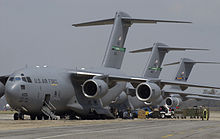Boeing C-17 Globemaster III
The Boeing C-17 Globemaster III is a large military transport aircraft. It was developed for the United States Air Force (USAF) from the 1980s to the early 1990s by McDonnell Douglas. The C-17 carries the name of two previous piston-engined military cargo aircraft, the Douglas C-74 Globemaster and the Douglas C-124 Globemaster II. The C-17 commonly performs strategic airlift missions, transporting troops and cargo throughout the world; additional roles include tactical airlift, medical evacuation and airdrop duties.
Boeing, which merged with McDonnell Douglas in the 1990s, continues to manufacture C-17s for export customers following the end of deliveries to the U.S. Air Force. The C-17 is operated by the U.S. Air Force, the United Kingdom, Australia, Canada, Qatar, United Arab Emirates, NATO Heavy Airlift Wing, and India.
Design

The C-17 is 174 feet (53 m) long and has a wingspan of about 170 feet (52 m). It can airlift cargo fairly close to a battle area. The size and weight of U.S. mechanized firepower and equipment have grown in recent decades from increased air mobility requirements, particularly for large or heavy non-palletized outsize cargo.
The C-17 is powered by four Pratt & Whitney F117-PW-100 turbofan engines, which are based on the commercial Pratt and Whitney PW2040 used on the Boeing 757. Each engine is rated at 40,400 lbf (180 kN) of thrust. The engine's thrust reversers direct engine exhaust air upwards and forward, reducing the chances of foreign object damage by ingestion of runway debris, and providing enough reverse thrust to back the aircraft up on the ground while taxiing. The thrust reversers can also be used in flight at idle-reverse for added drag in maximum-rate descents.

The aircraft requires a crew of three (pilot, copilot, and loadmaster) for cargo operations. Cargo is loaded through a large aft ramp that accommodates rolling stock, such as a 69-ton (63-metric ton) M1 Abrams main battle tank, other armored vehicles, trucks, and trailers, along with palletized cargo. The cargo compartment is 88 feet (26.82 m) long by 18 feet (5.49 m) wide by 12 feet 4 inches (3.76 m) high. The cargo floor has rollers for palletized cargo that can be flipped to provide a flat floor suitable for vehicles and other rolling stock.

Maximum payload of the C-17 is 170,900 lb (77,500 kg), and its Maximum Takeoff Weight is 585,000 lb (265,350 kg). With a payload of 160,000 lb (72,600 kg) and an initial cruise altitude of 28,000 ft (8,500 m), the C-17 has an unrefueled range of about 2,400 nautical miles (4,400 km) on the first 71 aircraft, and 2,800 nautical miles (5,200 km) on all subsequent extended-range models that include sealed center wing bay as a fuel tank. Boeing informally calls these aircraft the C-17 ER. The C-17's cruise speed is about 450 knots (833 km/h) (Mach 0.74). It is designed to airdrop 102 paratroopers and their equipment. The U.S. Army's Ground Combat Vehicle is to be transported by the C-17.
The C-17 is designed to operate from runways as short as 3,500 ft (1,064 m) and as narrow as 90 ft (27 m). In addition, the C-17 can operate from unpaved, unimproved runways (although with greater chance of damage to the aircraft). The thrust reversers can be used to back the aircraft and reverse direction on narrow taxiways using a three- (or more) point turn.
Specifications (C-17)



Data from U.S. Air Force fact sheet, Boeing, and AerospaceWeb
General characteristics
- Crew: 3: 2 pilots, 1 loadmaster
-
Capacity:
- 102 paratroopers
- 134 troops with palletized and sidewall seats or
- 54 troops with sidewall seats (allows 13 cargo pallets) only or
- 36 litter and 54 ambulatory patients and medical attendants or
- Cargo, such as an M1 Abrams tank, three Strykers, or six M1117 Armored Security Vehicles
- Payload: 170,900 lb (77,519 kg) of cargo distributed at max over 18 463L master pallets or a mix of palletized cargo and vehicles
- Length: 174 ft (53 m)
- Wingspan: 169.8 ft (51.75 m)
- Height: 55.1 ft (16.8 m)
- Wing area: 3,800 ft² (353 m²)
- Empty weight: 282,500 lb (128,100 kg)
- Max. takeoff weight: 585,000 lb (265,350 kg)
- Powerplant: 4 × Pratt & Whitney F117-PW-100 turbofans, 40,440 lbf (180 kN) each
- Fuel capacity: 35,546 U.S. gal (134,556 L)
Performance
- Cruise speed: Mach 0.74 (450 knots, 515 mph, 830 km/h)
-
Range: 2,420 nmi (2,785 mi, 4,482 km) ; 5,610 nmi (10,390 km) with paratroops
- Service ceiling: 45,000 ft (13,716 m)
- Max. wing loading: 150 lb/ft² (750 kg/m²)
- Minimum thrust/weight: 0.277
-
Takeoff run at MTOW: 7,600 ft (2,316 m)
- Landing distance: 3,500 ft (1,060 m)
The information contained on this page is unclassified, approved for public dissemination and is released under CC-BY-SA Licensing Agreement.

